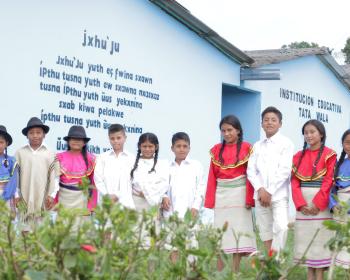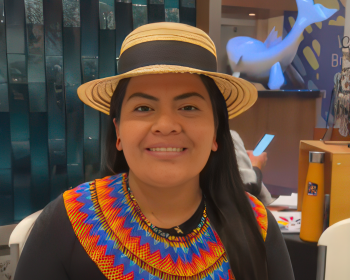The case of the experimental farm at Purace in the Department of Cauca in southwestern Colombia is notable for several reasons. First, it represents successful land reclamation in an area of severe environmental degradation. Second, the Purace farm is the product of local organizing and education efforts in sustainable resource management. It was designed, planned and implemented by members of the indigenous community in collaboration with specialists who were invited to impart skills to the local inhabitants. Now, in the Department of Cauca, white farmers turn to Indian farmers for advice on resource management.
Cauca, with the largest Indian population of any department - 200,000 people - is also one of Colombia's poorest regions. A 1975 inquiry by the Colombian Institute for Agrarian Reform (INCORA) in the department showed an average annual income of less than US$100 per person.
This part of the Andean Cordilleras, which lies at 2,000-5,000 meters above sea level, is characterized by an irregular, rough topography. Where the gradient is steep, large-scale land clearing for agriculture and ranching has left behind leached and infertile soils. Adjacent to the rugged Department of Cauca are the rolling plains of the neighboring Cauca Valley, the fertile floodplains of which support the largest and most productive sugar plantations in Colombia. The lush agricultural production of the valley contrasts vividly with the environmental devastation and widespread poverty of the adjacent department.
Rural poor, displaced from the valley by large plantations, settled in the less desirable, adjacent areas, such as Purace, straining its poor land resources. Intense population pressure for little arable land resulted in both land tenure disputes and resource exhaustion. These conditions have produced tensions and attracted both guerrillas and government counterinsurgency troops. The number of arrests, tortures and assassinations in the area has aroused the concern of international human rights organizations.
Brief History
The Coconuco and Paez Indians have occupied the Purace portion of Cauca since at least the sixteenth century.(1) When the Coconuco assisted them in defeating the Paez in 1582, the Spanish awarded the Coconuco with a tract of land known as a resguardo. With the regularization of Colombian land legislation, the resguardo of Purace was formally recognized as belonging to the Coconuco. In 1892 they received title to 9,600 ha.
In 1945, however, the Colombian government authorized strip mining for sulphur inside the supposedly protected resguardo. Six hundred hectares, including a religious shrine, were visibly stripped of all vegetation. The destruction, however, was not restricted to the immediate area of the mine. Sulphur oxides and waste gases escaped from the mine, destroying crops and pastures and endangering the health of the local residents. According to a Colombian government official of INCORA, cited by a witness at the Fourth Russell Tribunal, the toxic fumes "converted at least 1,000 ha of arable land into sterile wasteland".(2)
Estimates suggest that sulphuric contamination rendered 2,600 ha of the resguardo nonarable, leaving 7,000 ha of usable land. Even so, the resguardo was further reduced in 1963 when INCORA expropriated more than half of the remaining arable land - 3,600 ha - to form a national park.
As a result of the combined reduction of land by government expropriation and toxic contamination, the original 9,600 ha promised by the government in 1892 was reduced to only 3,400 arable hectares. A report by INCORA estimated that 3,400 ha could sustain approximately 118 families. Yet the number of families living at Purace was 280: more than twice INCORA's estimate.
Under the weight of increasing economic and political difficulties, the Regional Indian Council of Cauca (CRIC) was formed in 1972. CRIC's initial purposes, as stated in its seven-point program, were to demarcate and entitle indigenous lands, protect Indian rights and promote Indian culture and education. After 12 years of work in these areas, CRIC restated its priorities to emphasize economic assistance. In its 1984 platform, environmental restoration and production were made first-order priorities (CRIC 1983). CRIC's accomplishments since that time have been impressive. Two model production efforts have been its reforestation program and the experimental agricultural station at Purace.
The Experimental Agriculture Station
Restoration of deteriorated lands was foremost on CRIC's agenda. As one of its first efforts in a larger land management program, CRIC initiated an experimental station at Purace in 1985. In the early stages of the project a Danish agronomist worked with the community to develop appropriate land-use methods. Today, the station provides a major portion of food consumed in the region. The station's farm is managed by a council of leaders, or cabildo. which rotates annually. The cabildo acts as creditor to the community, providing temporary funds for necessary purchases such as seeds and sprinklers.
Utilizing simple technologies, community members perform most of the farm work. Experts offer advice during an initial training phase and visit the project at varying intervals. These specialists are not expected to enter into the decision-making process, but they are expected to introduce training and skills to the community.
In the cabildo office hangs a calendar indicating the days each community is committed to work. The farm is worked in rotation: eight different communal units alternate work days, with each community working seven days per year. Their members live within an approximate radius of 4 km from the farm.
The community first sells the harvest to its own members at prices below the current market value; any surplus is then sold in markets in the town of Purace and the city of Popayán. The cabildo is repaid from the sales and any profits are reinvested in the project.
Following the harvest, assisting technicians carry out a three-day evaluation to determine which practices were successful, and therefore ought to be continued, and which were not. The evaluators present recommendations to the community, which then decides future crop inventories and schedules.
In the past, few crops would grow in the nutrient-deficient, contaminated soils of Purace. The potato, the single crop that could be grown near Purace, had come to serve as the mainstay of the local diet. The farm's purpose was to replace some of the diversity in cultigens that had been destroyed by contamination - principal among these was wheat.
Although wheat is an important domestic and economic food to the residents of Purace, they could not obtain it locally. Because of its high nutrient requirements, it was questionable whether wheat could be grown at all in Purace's nutrient-poor soils. Acid rain created by sulphur emissions had reduced the exchange capacity of the soils, leaving them acidic and impoverished. Wheat could, therefore, only be grown with nutrient additives. Students from the nearby agricultural institute. Institute Tecnico Agropecuario (ITA), presented the community with several alternative preparations of organic fertilizers. Community members now make their own composts with the byproducts of farm produce. By creating demonstration plots grown both with and without nutrient additives, the community can decide whether the increased yields are worth the additional labor investment.
Given the magnitude of problems at Purace, these simple results are impressive. The question of whether the techniques practiced at the farm are durable, or generalizable, will be decided in time by the persons who practice them and benefit from them.
Since the farm at Purace was established, residents purchase wheat through the community at about half the market price (800cp per unit through the community supply,(3) as opposed to 1,50 cp per unit in the market). For the past 40 years the residents of Purace had to travel in order to buy wheat to make bread. Thriving on lands once thought to be sterile, wheat has now become an important symbol of environmental regeneration and local self-empowerment.
Notes
(1). A third group, the Guambiano, also inhabited the Cauca in that century.
(2). This case was brought before the Fourth Russell Tribunal on the Rights of the Indians of the Americas, Rotterdam, November 1980.
(3). These figures are in Colombian pesos.
Article copyright Cultural Survival, Inc.


